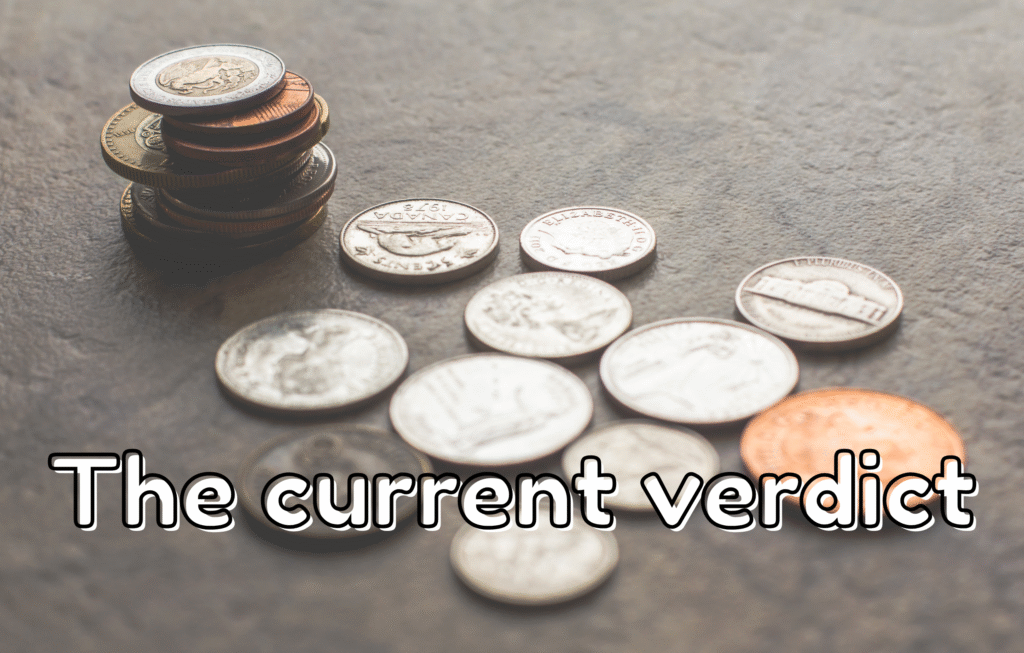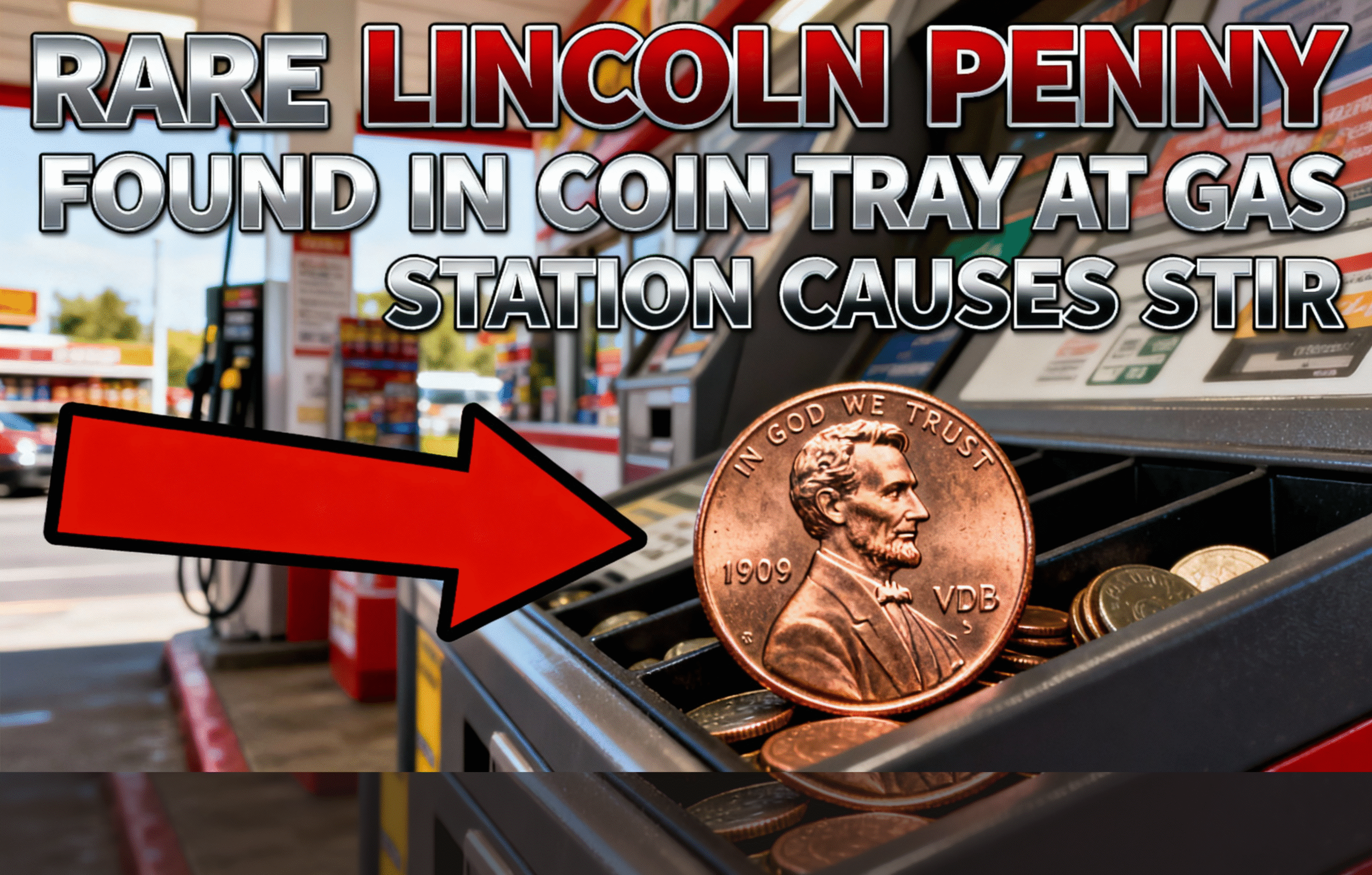Strange Lincoln Penny Found in a Gas Pump Coin Tray Sparks Speculation
Every so often a story surfaces in the coin‑collecting world that captures the imagination: a seemingly mundane find—often tossed away or overlooked—turns out to be something very rare. Recently one such story has been doing the rounds: a Lincoln penny found in a coin tray at a gas pump, described as having odd features, prompting collectors to wonder: is it a rare error, a “wrong planchet,” or just damage / wear / corrosion?
This article examines: what we know, what is credible vs. speculative, the kinds of anomalies coin experts look for, and what steps one should take if they believe they have discovered something unusual in everyday change.
What’s circulating: The story so far
- The origin of the story appears to be someone finding a Lincoln penny in the “take‑a‑penny / leave‑a‑penny” tray (the penny tray) at a gas station. This coin allegedly has “strange” qualities: unusual color or metal sheen, possibly the wrong composition, or something off about the date or letters.
- So far, no large name numismatic publication has confirmed the penny was authenticated after rigorous testing (e.g. through PCGS, NGC). Most reports are social media / coin forums, where images are shared and speculation arises.
Because of that, much of what is “known” remains unverified. But stories like this follow a common pattern in coin‑enthusiast communities, so it’s worth examining what kinds of “strange pennies” have turned up in the past, what makes them rare or valuable, and how to tell whether they’re authentic or just curiosities.
Precedents: Strange / valuable Lincoln pennies found in circulation
To understand what might make this gas‑pump tray penny special, it helps to consider confirmed precedents. These are cases where someone found a penny (or similar coin) in a tray, change jar, piggy bank, etc., and it turned out to be rare.
- A good example: a 1992‑D “Close AM” Lincoln cent found in a gas station’s “leave a penny, take a penny” tray by a collector in Michigan. It turned out to be a rare variety, with fewer than 100 known specimens across grading services.
- Also, “take a penny” trays or cashiers’ coin jars have, in several anecdotal cases, revealed older pennies (Wheat cents, early Lincoln heads) or coins with odd errors—but many of these are either low value or in degraded condition, which limits their rarity premium.
These and similar stories give coin collectors hope that rare items still circulate, even if in dusty, overlooked places.
What makes a Lincoln penny “strange” / potentially valuable
If a penny is more than just face value, there are a few features that typically attract specialist interest:
- Wrong metal / wrong planchet errors
- For example, the famous 1943 copper‑(bronze) Lincoln penny: in 1943 most Lincoln cents were supposed to be made of zinc‑coated steel due to copper shortages in World War II. A small number of copper planchets from earlier batches slipped through occasionally, producing rare pennies in copper for that year. Because so few exist, when one is found and authenticated, it becomes extremely valuable.
- Conversely, sometimes pennies that should be copper are struck on steel or other planchets. These “off‑metal” errors are of interest.
- Minting errors and die anomalies
- Errors like doubling (doubled die), misaligned dies, missing letters or partial letters, die cracks, or irregular striking (off‑center, weak strikes).
- Also odd edge work, clipped planchets, or severely rotated dies.
- Unusual condition or preservation
- A penny that has managed to avoid corrosion, wear, or cleaning (which frequently lowers its numismatic value).
- If the anomaly is very crisp, with sharp details, clean fields, untouched surfaces, and correct weight / composition, then it has more chance of being rare/valuable.
- Provenance and documentation
- If the find can be documented: where and when it was found, chain of ownership, and if possible, submission to an expert grading service. Without such validation, market value is speculative.
What is likely / what is unlikely in the gas pump penny case
Given what we know about similar stories, here are what seem plausible vs. less likely regarding the recent gas pump penny find.
Likely
- The penny might have superficial anomalies: odd color / patina, odd wear, or discoloration. These can be caused by exposure to chemicals (gas station environment, petroleum, moisture), by being in contact with other metals, or being exposed to heat, etc.
- It may be an older penny (e.g. a Lincoln Wheat penny) that survived in better condition, perhaps less circulated. That alone can make it more interesting to collectors.
- It might have a minor die error or some unusual wear that makes it “look odd” in photos (e.g. double stamping, weak die detail), even if the coin isn’t especially valuable.
Unlikely (or needs strong evidence)
- That it is a super‑rare error like a 1943 copper planchet penny—or any other “holy grail” rarity—without proper authentication. Such finds are extremely rare, and stories of them tend to get exaggerated in retellings.
- That it will immediately fetch a very large value unless its condition, rarity, and validated status are all thoroughly documented. Many loose reports of “this is worth thousands” or “this is a million‑dollar penny” often overshoot what the market will pay when all factors are considered.
- That odd color or sheen alone is sufficient evidence of off‑metal; visual inspection can mislead, especially with patina, corrosion, or alteration.
Recent similar claims and their status

As of mid‑2025, there are a few claims floating in forums or less formal media about extraordinary finds in coin trays or gas stations. Many of them are anecdotal, with photographs but no well‑documented grading or public auction results. Sometimes customers or gas station workers report finding “rare pennies” in coin trays, but often after inspection they turn out to be “interesting but not ultra‑rare” errors, or just well‑preserved common coins.
One credible example: the 1992‑D “Close AM” cent mentioned above, which has been authenticated and has established rarity.
Another example (less well‑verified) is someone claiming to pick up a 1943 bronze (copper) penny at a gas station. Such stories often gain attention, but until inspected under strict scientific and numismatic protocols—weight, metal composition, dies, documentation—they remain speculative.
What to do if you think you have one
If you came upon a penny that looks strange, either in a coin tray, your change, or anywhere else, here’s a recommended course of action:
- Do not alter clean or polish it. Cleaning often destroys provenance, obscures details, and can reduce value.
- Weigh it (if possible) and measure diameter and thickness. Compare to known standards for that year of penny. Off‑metal pieces will often deviate in these metrics.
- Examine under magnification: Check for die markers, doubled letters, misalignments, or any anomalies in the date, mint mark, etc. Compare with high‑resolution images of known errors.
- Seek expert opinions. Submit photos with good lighting to coin‑collecting forums or numismatic societies, ideally ones with moderation and reputation. But more importantly, send the coin for professional authentication (grading, composition testing) if you believe it may be rare. Companies like PCGS, NGC (USA) etc.
- Document its origin. Where exactly you found it (gas station, coin tray, date), condition, your observations. That helps with provenance which can influence collector value.
- Be realistic. Many “strange coins” are interesting but not worth huge sums. Rarity + demand + condition = value. Eyeball anomalies are exciting, but the majority of value comes from what can be scientifically measured and accepted by collectors.
Why such stories capture attention
Coin‑collecting has long had a fascination with the idea that extraordinary value can be hiding in everyday objects: your pocket change, old jars, drawers, or coin trays at stores. These tales resonate because:
- They suggest that treasure is accessible, even for non‑collectors. Anyone could, in principle, stumble on a rare piece.
- They combine history, chance, and possibility: a coin from a critical year (war‑time, transitions in metal usage), a mint error, etc., is appealing.
- Stories spread fast: on social media, forums, meme culture. Once someone claims a find, others want to check their change too.
These stories also help educate people about coin errors, minting history, and standards, because they prompt discussion: what makes a coin rare, how to authenticate, what has been documented historically.
The current verdict

At this moment:
- We don’t have verifiable evidence that the gas‑pump tray penny is a confirmed ultra‑rare error (e.g. 1943 bronze) or mis‑struck planchet.
- The “strange” attributes (color, sheen, look) are enough to raise interest and speculation, but not yet enough to confirm value.
- The story remains in the realm of “possible but unproven.”
If further information becomes available—photos, expert grading, weight/composition data—then this could shift. For now, it’s one of many such stories that illustrate how collectors and hobbyists stay alert, because once in a while, one of these “everyday finds” turns out to be legitimately remarkable.
Conclusion
The tale of the strange Lincoln penny from a gas pump coin tray is likely a mix of reality and speculation. It underscores how even today, rare coins may still be hiding in plain sight—but also how careful one must be with claims of extreme value.
For anyone who finds something odd in their change: treat it with care, document it, consult experts, and keep expectations measured. Because the truth is, while not every “off‑metal penny” is a $1 million‑plus find, the possibility that something special slipped through minting or circulation is real—and that’s part of what makes coin collecting endlessly fascinating.
FAQs
1. What was found in the gas pump coin tray?
A Lincoln penny with strange visual traits—unusual color, possible metal anomalies, or minting issues—was reportedly found in a coin tray at a gas station, sparking collector speculation.
2. Has the gas pump penny been authenticated?
No. As of now, no official grading service like PCGS or NGC has confirmed the coin’s authenticity or rarity. Most reports are forum-based and remain unverified.
3. What kinds of errors make Lincoln pennies valuable?
Valuable errors include off-metal planchets, doubled dies, misaligned strikes, clipped edges, and unusual minting flaws. These must be authenticated and typically command higher prices in good condition.
